
Flying Aircraft Carriers of the USAF: Project FICON |
![]()
 In the early years of the cold war,
the United States Air Force was faced with a requirement for an
airplane that could photograph targets deep inside the Soviet
Union. Many strategic targets were inaccessible to conventional
U. S. reconnaissance airplanes. There was no airplane with
sufficient range to reach these targets that also possessed the
speed and maneuverability to evade Soviet air defenses.
In the early years of the cold war,
the United States Air Force was faced with a requirement for an
airplane that could photograph targets deep inside the Soviet
Union. Many strategic targets were inaccessible to conventional
U. S. reconnaissance airplanes. There was no airplane with
sufficient range to reach these targets that also possessed the
speed and maneuverability to evade Soviet air defenses.
It was envisioned that Fighter Conveyer (FICON) composite aircraft would perform long-range reconnaissance missions into areas equipped with anti-aircraft defenses that existing reconnaissance airplanes could not penetrate. FICON operations would rely on the great range of the Convair RB-36 to carry a jet powered parasite airplane to a location within range of targets inside defended territory. The high speed and maneuverability of the parasite would allow it to dash into enemy territory to take pictures of the targets and then rendezvous with its flying aircraft carrier to be carried back to its home base. Many targets that were out of range of conventional reconnaissance airplanes would be accessible to the FICON parasite airplane.
The American Aviation Historical Society published the first installment of my history of Project FICON in the Summer 2003 edition of their Journal. Join the A.A.H.S. to get your copy of the entire history.
 The American Aviation Historical Society. was
founded in 1956 as a non-profit educational organization. Now you
can join over 3,000 aviation enthusiasts worldwide in a common
cause to share in the preservation and propagation of the rich
heritage of American Aviation.
The American Aviation Historical Society. was
founded in 1956 as a non-profit educational organization. Now you
can join over 3,000 aviation enthusiasts worldwide in a common
cause to share in the preservation and propagation of the rich
heritage of American Aviation.
![]() Hobbycraft has released a
1/144-scale model of the FICON composite aircraft system. I have
prepared an illustrated review
of the kit.
Hobbycraft has released a
1/144-scale model of the FICON composite aircraft system. I have
prepared an illustrated review
of the kit.
In the years following World War II, the Air Force modified many heavy bombers to serve as reconnaissance airplanes. Boeing B-29 Superfortresses were converted to serve as photographic reconnaissance platforms. The reconnaissance versions of the Superfortress were given the designation F-13. They had great endurance and could carry large format cameras. These reconnaissance bombers flew long missions along the perimeter of Soviet Bloc countries. They took long-range oblique photographs into the interior of the target countries using extremely long focal-length telephoto lenses. The detailed images were recorded on film that was 18 inches wide. They also used the electronic reconnaissance gear to ferret out sources of radio, radar, and telemetry signals within the target countries.
The giant Convair B-36 was used extensively for reconnaissance in the early post-war period. They were built in two major versions, the standard B-36 bomber variant and the RB-36 version tailored for aerial reconnaissance. The B-36 bomber was equipped with four bomb bays. The RB-36 version had an additional pressurized compartment for camera gear in place of the forward bomb bay of the B-36 bomber.
In the early years of its deployment, the RB-36 was very difficult to intercept. It could cruise at altitudes that jet fighters could not reach. If a fighter did succeed in climbing to the altitude of the RB-36, the lower wing loading of the RB-36 allowed it to turn tighter than the fighter could. The RB-36 could simply turn out of the way of a fighter as it mushed along at a speed only slightly higher than its stall speed.
The maneuvering advantage of the RB-36s did not last long. The Soviet Union was quickly developing more capable interceptors with superior high altitude performance. It was clear that jet fighters with the ability to intercept the RB-36 would be entering service in the Soviet Air Force by the middle of the 1950s. It would become too dangerous to operate the RB-36 on reconnaissance missions near the borders of the Soviet Union.
By June 1954, the Air Force would change the primary mission of the four Strategic Reconnaissance (Heavy) Wings that were equipped with RB-36s from reconnaissance to bombing. The RB-36s would no longer be used for the mission of strategic reconnaissance. They were modified to carry nuclear weapons as strategic bombers.
A new aircraft was needed for the strategic reconnaissance role. The new aircraft needed the long range of the RB-36 and the speed and maneuverability of a jet fighter. Many thought that it would not be possible to accomplish the projected mission with a conventional airplane. It was proposed that strategic reconnaissance missions could be performed by tactical jet fighters that were launched from RB-36s near the borders of the target countries.
In 1950, in anticipation of the eventual retirement of the RB-36 fleet from the reconnaissance role, the Air Force initiated a program to equip RB-36s with a mechanism to carry a smaller reconnaissance airplane. The smaller airplane would have the speed and maneuverability to penetrate enemy air defenses in the place of the RB-36. The RB-36 would transport the parasite to the enemy zone, where it would be released to perform its own reconnaissance mission. After completing its mission, the parasite would rendezvous with the RB-36 to be retrieved and carried back to its home base.
Initial tests were conducted with a modified Convair RB-36F and straight-winged Republic F-84E Thunderjet at the Convair factory in Fort Worth, Texas.
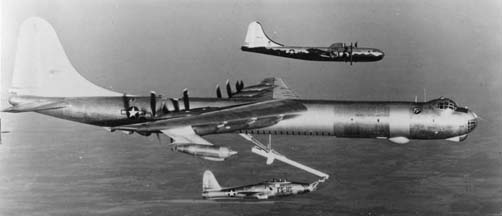 Major Clarence "Bud"
Anderson made the first attempt to hook F-84E, 49-2115 to the
GRB-36F, 49-2707 over Texas on January 9, 1952. A B-29
Superfortress is flying chase off their left wing. Air Force
Photo 46206AC via National Archive.
Major Clarence "Bud"
Anderson made the first attempt to hook F-84E, 49-2115 to the
GRB-36F, 49-2707 over Texas on January 9, 1952. A B-29
Superfortress is flying chase off their left wing. Air Force
Photo 46206AC via National Archive.
Bud Anderson is a WWII Triple Ace who flew the P-51 Mustang, "Old Crow" while assigned to the 357th Fighter Group "Yoxford Boys", 8th Air Force, Leiston Field, United Kingdom.
Visit the Clarence E.
"Bud" Anderson web site. I highly recommend buying
and reading a copy of his book, To Fly and Fight. It
contains his first person accounts of the early FICON test
flights. 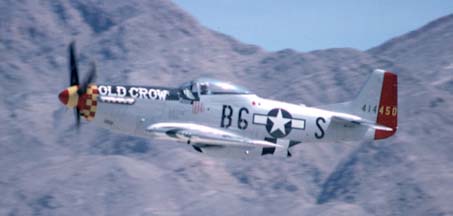
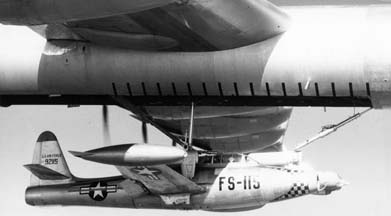 FICON flight tests moved to the Air
Proving Ground at Eglin AFB, Florida in the second half of 1952.
Photo courtesy: Bud Anderson.
FICON flight tests moved to the Air
Proving Ground at Eglin AFB, Florida in the second half of 1952.
Photo courtesy: Bud Anderson.
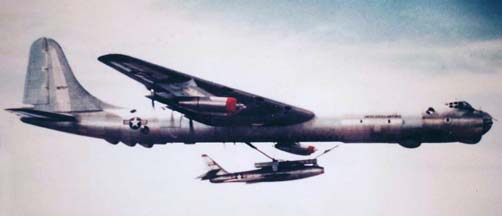 Follow-on FICON tests were conducted with the
sweptwing prototype YRF-84F Thunderstreak at the Convair factory
in Fort Worth and the Air Proving Ground at Eglin AFB in 1953 and
1954. Photo courtesy: Air Force Museum.
Follow-on FICON tests were conducted with the
sweptwing prototype YRF-84F Thunderstreak at the Convair factory
in Fort Worth and the Air Proving Ground at Eglin AFB in 1953 and
1954. Photo courtesy: Air Force Museum.
![]() The YRF-84F had served as the
prototype of the swept-wing F-84F Thunderstreak. It had been
modified from a straight-wing F-84E. Note the hook on the nose
for catching the trapeze and the downward sloping horizontal
stabilizer to clear the bomb bay of the B-36. Note also the pin
protruding from the side of the fuselage which provided another
point of attachment to the trapeze. Republic photo #26-1632
courtesy: Fairchild Hiller.
The YRF-84F had served as the
prototype of the swept-wing F-84F Thunderstreak. It had been
modified from a straight-wing F-84E. Note the hook on the nose
for catching the trapeze and the downward sloping horizontal
stabilizer to clear the bomb bay of the B-36. Note also the pin
protruding from the side of the fuselage which provided another
point of attachment to the trapeze. Republic photo #26-1632
courtesy: Fairchild Hiller.
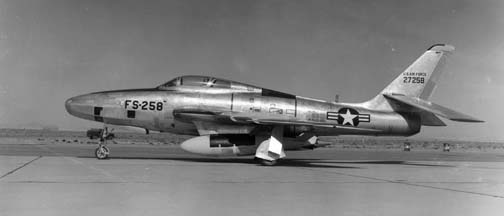 Twenty-six Republic RF-84F
Thunderflashes were converted to the FICON parasite
configuration. Ten RB-36Ds were converted to serve as FICON
carriers. Air Force Photo B-161916AC via National Archive.
Twenty-six Republic RF-84F
Thunderflashes were converted to the FICON parasite
configuration. Ten RB-36Ds were converted to serve as FICON
carriers. Air Force Photo B-161916AC via National Archive.
Republic RF-84F/K ThunderflashWingspan: 34 feetLength: 48 feetWing Area: 325 square feetMaximum Take-off Weight: 27,000 poundsArmament: 4x 50 caliber machine gunsPowerplant: 7,800 pound s.t. J65 turbojet |
![]() Initial tests of the production
version of the FICON GRB-36D/RF-84F composite aircraft were
conducted by Convair in Fort Worth in December 1954. Convair
photo 26-1916 courtesy: Lockheed-Martin.
Initial tests of the production
version of the FICON GRB-36D/RF-84F composite aircraft were
conducted by Convair in Fort Worth in December 1954. Convair
photo 26-1916 courtesy: Lockheed-Martin.
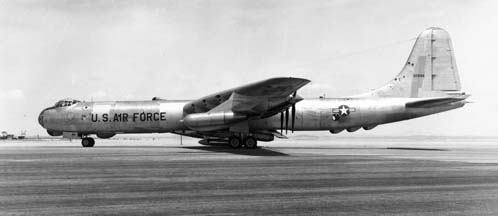 The Air Force conducted evaluations
of the FICON composite aircraft system at the Air Proving Ground
at Eglin AFB, Florida, the Air Force Special Weapons Center at
Kirtland AFB, New Mexico, and the Air Force Flight Test Center at
Edwards AFB, California in 1955 and 1956. Air Force Photo
A-162244AC via National Archive.
The Air Force conducted evaluations
of the FICON composite aircraft system at the Air Proving Ground
at Eglin AFB, Florida, the Air Force Special Weapons Center at
Kirtland AFB, New Mexico, and the Air Force Flight Test Center at
Edwards AFB, California in 1955 and 1956. Air Force Photo
A-162244AC via National Archive.
The FICON Flight Handbook, Illustrated Parts Breakdown, and Maintenance Handbook defined the modifications and operational procedures of the composite aircraft system.
![]() Trapeze Operator's Station
illustration from the Flight Handbook for the GRB-36D/RF-84F
Composite Aircraft. Courtesy: Roger Cripliver.
Trapeze Operator's Station
illustration from the Flight Handbook for the GRB-36D/RF-84F
Composite Aircraft. Courtesy: Roger Cripliver.
![]() An illustration of the trapeze mechanism from the GRB-36D/RF-84K
Limited Phase IV Flight Evaluation document. Courtesy: Air
Force Flight Test Center history Office.
An illustration of the trapeze mechanism from the GRB-36D/RF-84K
Limited Phase IV Flight Evaluation document. Courtesy: Air
Force Flight Test Center history Office.
![]() Cutaway view of the GRB-36D from
the Standard Aircraft Characteristics document for the
Consolidated GRB-36D and the Republic RF-84F. Courtesy: Air
Force Museum.
Cutaway view of the GRB-36D from
the Standard Aircraft Characteristics document for the
Consolidated GRB-36D and the Republic RF-84F. Courtesy: Air
Force Museum.
![]() The 91st Strategic Reconnaissance
Squadron operated FICON RBF-84F Thunderflashes at Larson AFB,
Washington. From front to rear these are 52-7268, 52-7266,
52-7269, 52-7260, and 52-7262. Republic photo16975 via Fairchild
Hiller.
The 91st Strategic Reconnaissance
Squadron operated FICON RBF-84F Thunderflashes at Larson AFB,
Washington. From front to rear these are 52-7268, 52-7266,
52-7269, 52-7260, and 52-7262. Republic photo16975 via Fairchild
Hiller.
![]() The 348 Bombardment Squadron
operated GRB-36D carriers at nearby Fairchild AFB, Washington.
Photo courtesy: Dave Menard via John Graff.
The 348 Bombardment Squadron
operated GRB-36D carriers at nearby Fairchild AFB, Washington.
Photo courtesy: Dave Menard via John Graff.
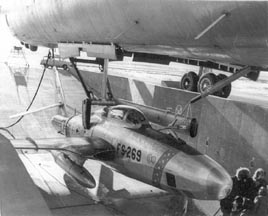 FICON training operations were
undertaken in December 1955, but they were concluded in January
1956 after several pilots from the 91st Strategic Reconnaissance
Squadron had damaged their airplanes trying to hook on to the
trapeze. Photo courtesy: Air Force Museum.
FICON training operations were
undertaken in December 1955, but they were concluded in January
1956 after several pilots from the 91st Strategic Reconnaissance
Squadron had damaged their airplanes trying to hook on to the
trapeze. Photo courtesy: Air Force Museum.
The complex and dangerous FICON composite aircraft system was overtaken by the development of the Boeing B-52 Stratofortress, the Lockheed U-2, and aerial refueling using the flying boom method. The FICON Thunderflashes were transferred to the Air National Guard. The GRB-36D carriers were scrapped in short order.
Several of the FICON parasite airplanes are preserved in museums.
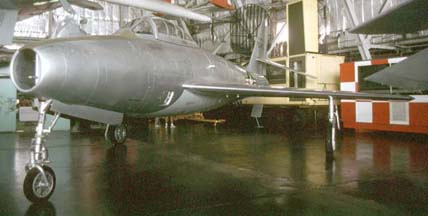 Today the YRF-84F, 49-2430 resides
in the Air Force Museum. Photographer: Brian Lockett.
Today the YRF-84F, 49-2430 resides
in the Air Force Museum. Photographer: Brian Lockett.
![]() The pre-production RF-84K, 51-1847
is also at the United States Air Force Museum. Photo courtesy
Greg Spahr.
The pre-production RF-84K, 51-1847
is also at the United States Air Force Museum. Photo courtesy
Greg Spahr.
Link to the United States Air Force Museum
![]() RF-84K, 52-7259 is at the Yankee
Air Museum, Ypsilanti, MI. It has been restored since this
photograph was taken. Photo courtesy Greg Spahr.
RF-84K, 52-7259 is at the Yankee
Air Museum, Ypsilanti, MI. It has been restored since this
photograph was taken. Photo courtesy Greg Spahr.
Link to the Yankee Air Museum
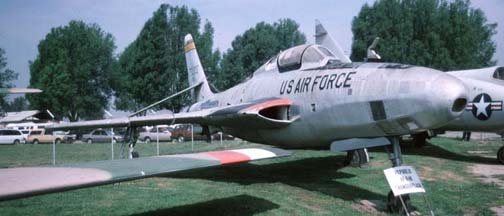 RF-84K, 52-7265 at the Planes of
Fame Museum at Chino, CA on March 15, 1997. Photographer: Brian
Lockett.
RF-84K, 52-7265 at the Planes of
Fame Museum at Chino, CA on March 15, 1997. Photographer: Brian
Lockett.
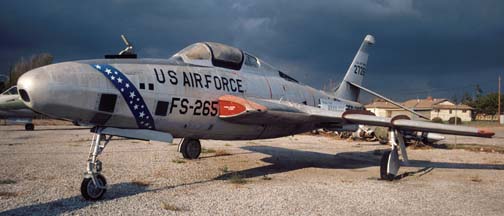 RF-84K, 52-7265 at the Planes of
Fame Museum on October 28, 2000.
RF-84K, 52-7265 at the Planes of
Fame Museum on October 28, 2000.
Link to the Planes of Fame Museum
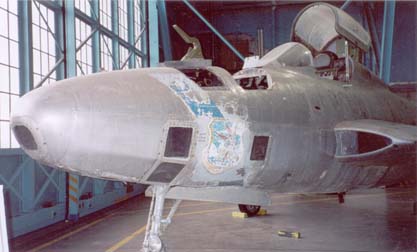 RF-84K, 52-7266 is currently
undergoing restoration at the Wings Over the Rockies Museum,
Denver, Colorado. Photo courtesy: John Graff of the Wings Over
the Rockies Museum restoration staff.
RF-84K, 52-7266 is currently
undergoing restoration at the Wings Over the Rockies Museum,
Denver, Colorado. Photo courtesy: John Graff of the Wings Over
the Rockies Museum restoration staff.
Link to the Wings Over the Rockies Museum
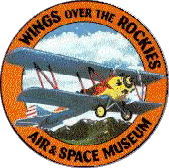
Rumor has it that there is another RF-84K at the George T. Baker aviation school, just off the departure end of 9L at the Miami Intl Airport.
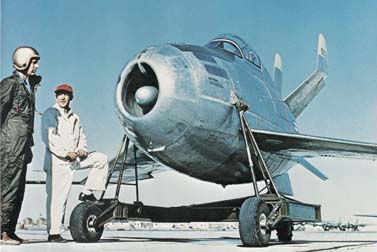 In
1948-49, a pair of McDonnell XF-85 Goblins
had been test flown from a Boeing EB-29B.
In
1948-49, a pair of McDonnell XF-85 Goblins
had been test flown from a Boeing EB-29B.
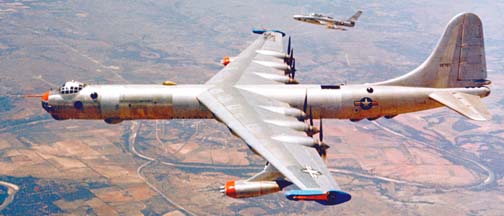 In 1956 Project Tom-Tom explored an alternative
method of attaching a Republic RF-84F Thunderflash to each
wingtip of a Peacemaker.
In 1956 Project Tom-Tom explored an alternative
method of attaching a Republic RF-84F Thunderflash to each
wingtip of a Peacemaker.
 Books about B-36 Peacemakers available from
Books about B-36 Peacemakers available from 
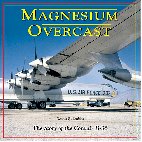 Dennis Jenkins has produced another large B-36 book: Magnesium Overcast.
Dennis Jenkins has produced another large B-36 book: Magnesium Overcast.
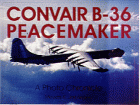 Meyers Jacobsen has authored
another book about the Convair B-36 Peacemaker: A Photo Chronicle.
Meyers Jacobsen has authored
another book about the Convair B-36 Peacemaker: A Photo Chronicle.
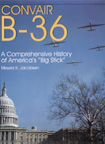 Convair B-36 : A Comprehensive History of America's
'Big Stick by Meyers K. Jacobsen. Mr. Jacobsen has been
compiling this history for at least a quarter of a century.
Convair B-36 : A Comprehensive History of America's
'Big Stick by Meyers K. Jacobsen. Mr. Jacobsen has been
compiling this history for at least a quarter of a century.
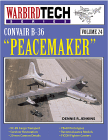 Warbird Tech: Convair B-36 Peacemaker . This volume by Dennis Jenkins contains a
surprising amount of information that did not get into "The
Big Stick".
Warbird Tech: Convair B-36 Peacemaker . This volume by Dennis Jenkins contains a
surprising amount of information that did not get into "The
Big Stick".
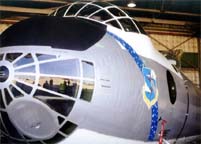 The history of the efforts to preserve B-36J, 52-22827 at Fort
Worth is well documented in "B-36: Saving the Last Peacemaker"; Second
Edition, an html book on CD.
The history of the efforts to preserve B-36J, 52-22827 at Fort
Worth is well documented in "B-36: Saving the Last Peacemaker"; Second
Edition, an html book on CD.
 Go
to the main Convair B-36 page.
Go
to the main Convair B-36 page.
Go to the home page of the Goleta Air
and Space Museum. 
Send a message to Brian.